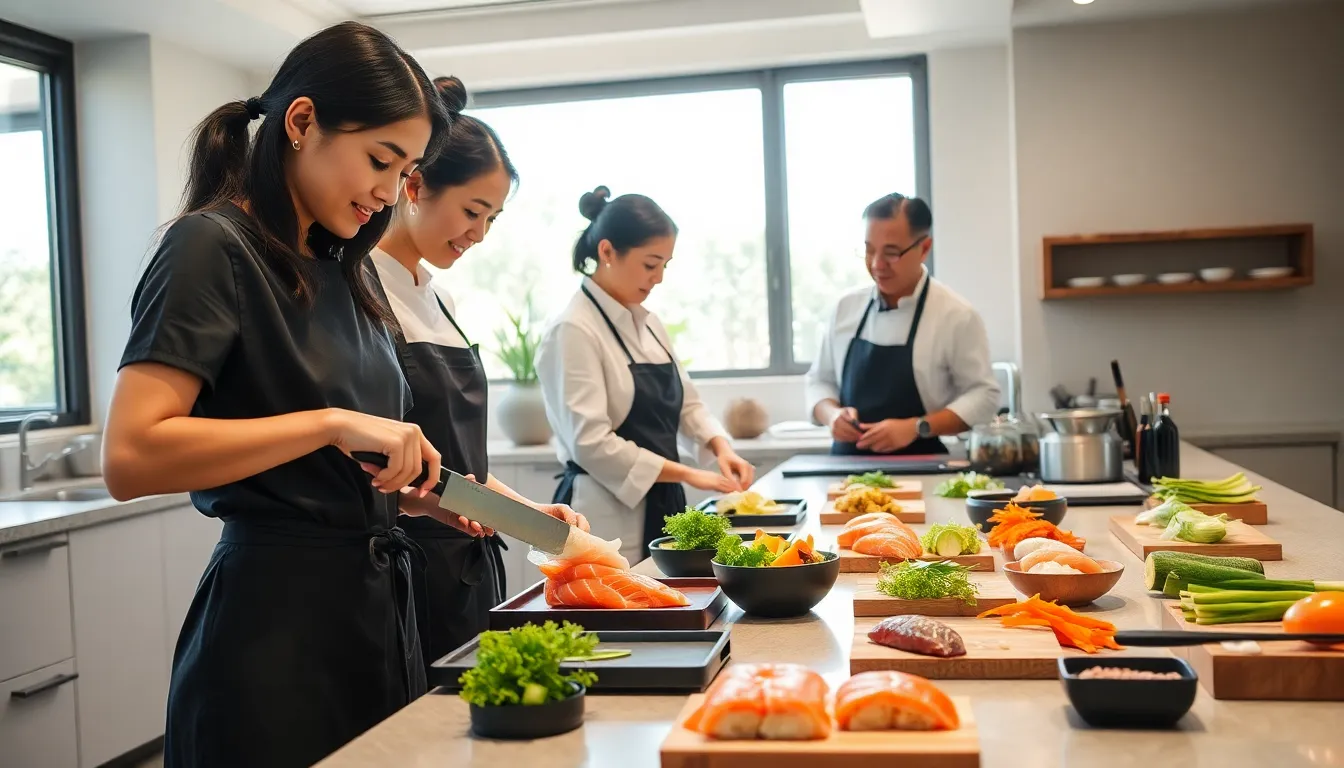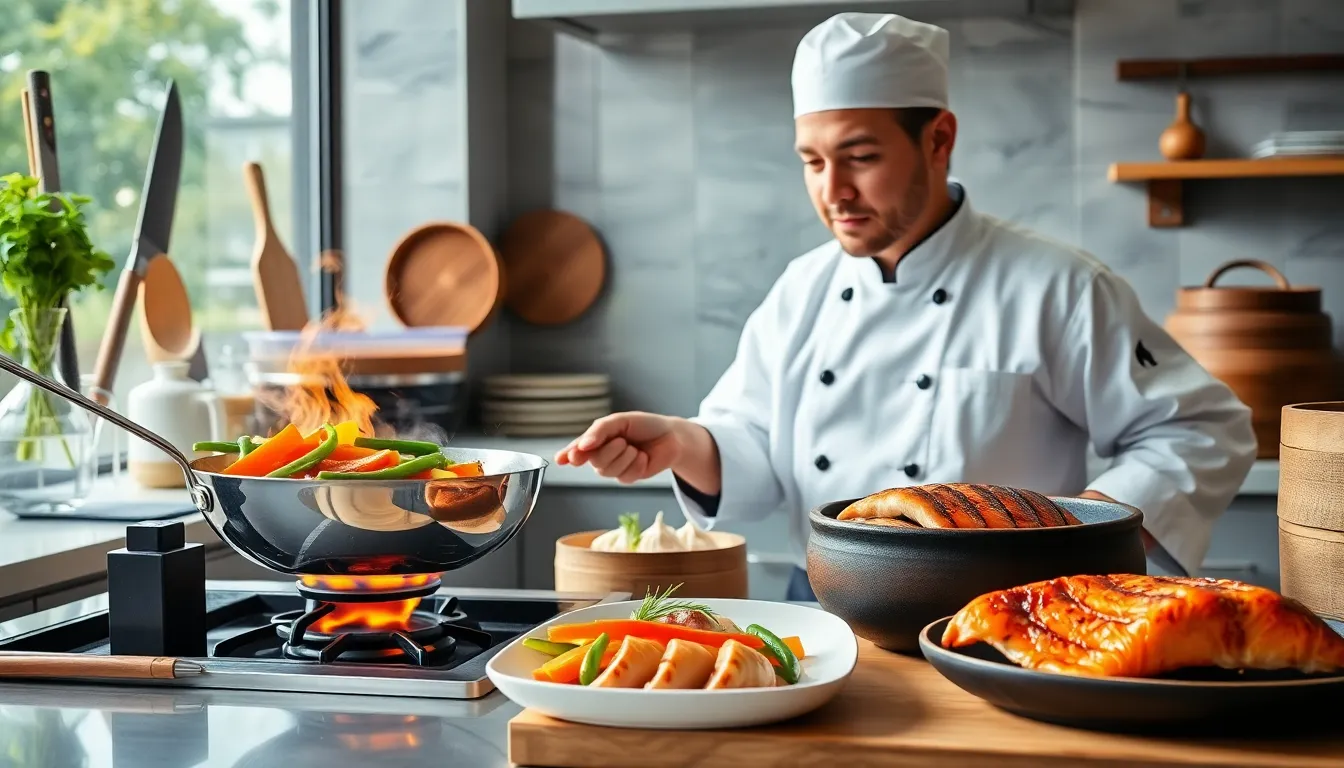Japanese cuisine is more than just sushi and ramen: it’s a symphony of techniques and flavors that entertains the palate while paying homage to tradition. If you think mastering Japanese cooking is as hard as solving a Rubik’s cube blindfolded, think again. With the right techniques up your sleeve, you too can whip up dishes that would make even a Michelin-star chef nod in approval. Get ready to dive deep into the heart of Japan’s culinary wonders, where each technique tells a story and every ingredient plays a key role. Let’s embark on this delicious adventure.
Table of Contents
ToggleUnderstanding the Basics of Japanese Cuisine

To appreciate Japanese cooking techniques, it’s essential to first grasp the underlying philosophy of the cuisine. Japanese food focuses on natural flavors and seasonal ingredients, highlighting freshness over heavy use of spices. Ingredients such as rice, fish, and vegetables are handled with care to maximize their potential. The concept of umami, often mentioned as the fifth taste, plays a central role in enhancing flavors, making it a cornerstone of Japanese dishes.
Understanding the balance of flavors is crucial, sweet, salty, sour, bitter, and savory should harmonize beautifully. This attention to detail reflects the aesthetic and cultural aspects of Japanese life, making every meal a visual and sensory feast.
Essential Japanese Cooking Techniques
Mastering Japanese cuisine involves familiarizing oneself with several essential techniques that form the backbone of many dishes. Here they are:
1. Sautéing and Stir-Frying (Itamemono)
Using a hot skillet or wok, this technique requires quick cooking over high heat while continuously stirring. Itamemono is perfect for preparing seasonal vegetables and proteins, allowing flavors to meld while keeping that delightful crunch.
2. Steaming (Mushi)
Steaming maintains the integrity and nutrients of ingredients, making it a popular method for cooking fish and dumplings. Traditional bamboo steamers not only cook food to perfection but also add a gentle hint of aroma that’s hard to replicate.
3. Grilling (Yaki)
Yaki techniques involve grilling over open flames or hot stones, bringing out the smoky essence of ingredients. Think grilled fish served with a slice of lemon, a dish celebrated for its simplicity and depth.
4. Simmering (Nimono)
This slow cooking method helps the ingredients to absorb flavors deeply. Whether it’s a hearty stew of root vegetables or braised meat, nimono showcases tenderness and rich harmony, a true comfort food approach.
5. Fermenting and Pickling (Tsukemono)
Tsukemono is a practice that has ancient roots in Japanese cooking. Fermented or pickled vegetables enhance dishes while providing delightful crunch and acidity, making them perfect for balancing flavors.
Unique Ingredients and Their Techniques
Japanese cooking is defined by its unique ingredients, each paired with techniques that enhance their natural flavors. Here are a few noteworthy highlights:
1. Rice Preparation and Cooking Techniques
Rice is more than a staple: it’s a cultural symbol. Japanese rice has a unique stickiness, making it perfect for sushi or donburi. The technique involves washing the grains to remove excess starch, soaking them to achieve the right texture, and then cooking them gently until fluffy.
2. Dashi: The Foundation of Flavor
Dashi is a broth made from kelp (kombu) and dried fish flakes (katsuobushi). Its umami-rich flavor is the cornerstone of many Japanese dishes, from miso soup to noodle broth. The preparation of dashi is essential: its quality elevates the entire dish.
3. Soy Sauce: Varieties and Uses
Soy sauce isn’t just a condiment: it’s a complex ingredient that can drastically alter the taste of a dish. Depending on the fermentation process and ingredients, it can range in flavor from sweet to savory. Understanding how to use different types of soy sauce is key to mastering Japanese flavors.
The Art of Presentation in Japanese Cooking
Presentation in Japanese cooking is an art form that reflects attention to detail and aesthetics. Each dish is carefully arranged, emphasizing color, shape, and balance. It’s not just what’s on the plate but how it’s served. For instance, using seasonal plates, garnishes, and the placement of food creates an experience as enjoyable to the eyes as it is to the palate.
The philosophy of ‘Ikebana’, the art of flower arrangement, inspires the way dishes are presented. Leafy greens may serve as a backdrop, while an accent piece like a radish or fine fish can draw the eye and create visual intrigue. Mastering this aspect not only elevates the cooking but transforms the meal into a celebration of culture.
Culinary Tools and Their Importance
Every chef knows that the right tools can make or break a dish. In Japanese cooking, specific tools are not only functional but also symbolically significant.
- Santoku Knife: A versatile knife suitable for slicing, dicing, and mincing, essential in any Japanese kitchen.
- Donabe: A traditional Japanese clay pot ideal for simmering stews or steaming foods.
- Tamago Pan: This rectangular skillet is crucial for making perfectly shaped Japanese omelets (tamago).
Using the proper tools does not just enhance efficiency: it fosters a greater appreciation for the cooking process, connecting the cook to centuries of tradition.





